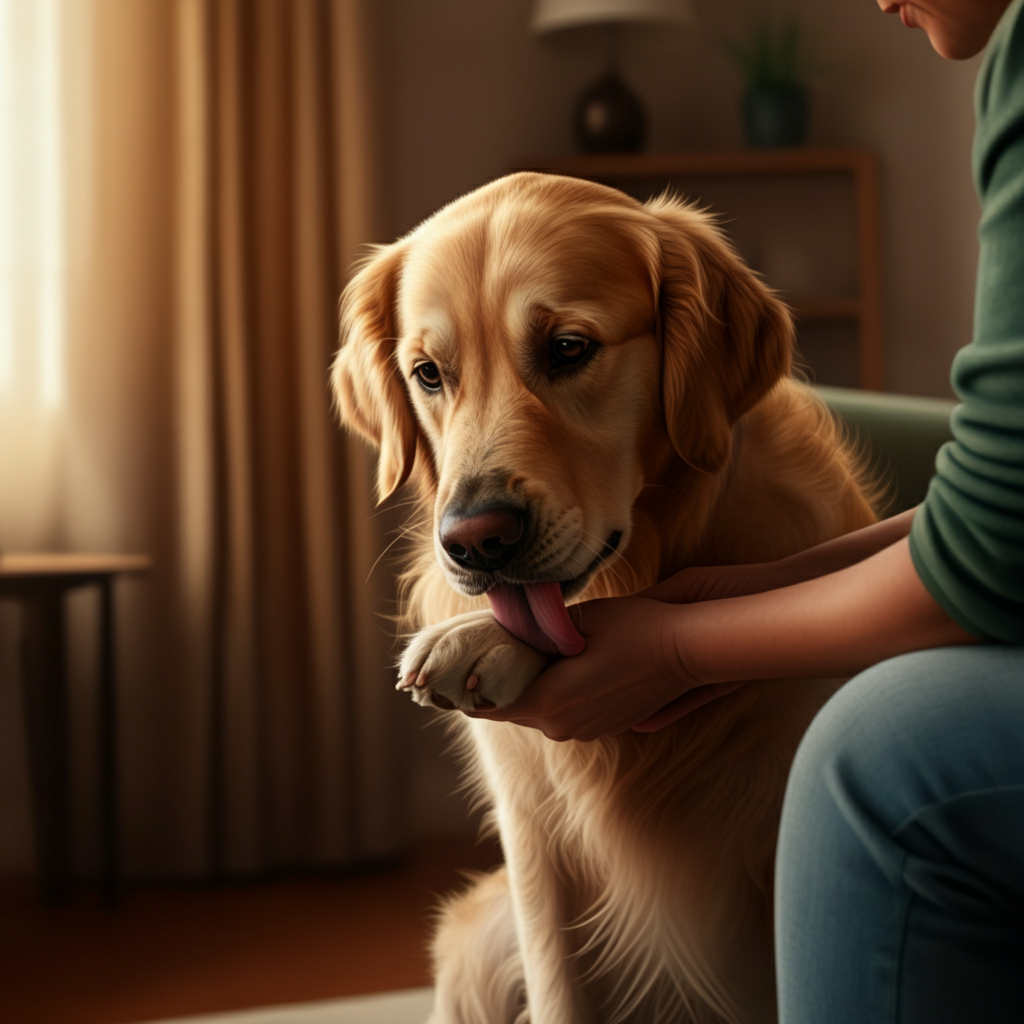What You Need to Know About Your Pet’s Habit
Dog owners regularly witness their canine companions licking their paws. It’s normal for dogs to spend minutes daily grooming, yet excessive licking sparks concern – a quirk or signal of trouble?
Understanding the motivations for a dog’s paw licking can assist recognition of early health issues and nourish well-being. This guide explores this ubiquitous behavior’s many potential causes, identifies problematic signs, and shares simple solutions to maintain happiness and health.
Common Reasons Behind Paw Licking Among Dogs
Dogs may lick their paws due to diverse triggers. Some motivations are obvious; others demand closer scrutiny or even veterinary evaluation. Chief among the causes:
Minor Abrasions or Embedded Debris
Stepping on something sharp like a stone, thorn or shard can irritate a paw, prompting self-treatment. Dogs employ mouths for impromptu wound care, removing dirt or cuts. Indicators comprise redness, swelling or embedded objects.
- Sensitivities
Allergies represent a primary driver of excessive paw licking as per veterinary doctors. Dogs may react adversely to certain foods, pollen, grass or cleaning solutions. Itchiness usually sparks constant licking, especially post-walks or allergen contact. Dermatologists sometimes recommend hypoallergenic diets to rule out dietary triggers. Environmental allergies can appear seasonally or year-round contingent on causative agents.
- Skin Conditions and Infections
Paws often fall victim to bacterial or yeast infections which cause discomfort and itching that dogs attempt to soothe through excessive licking. Look for signs like inflammation, strange odors, scaly patches or brownish discharge between the toes. Veterinarians regularly use skin cytology to identify whether microbes underlie the problem.
parasites like fleas, ticks and mites regularly plague dogs’ feet, eliciting intense itching. Canines will nibble and lap vigorously to assuage the irritation, watching closely for tiny black flea dirt or perpetual scratching.
- Parasites
Fleas, ticks, and mites can infest your dog’s paws, making them very itchy. Dogs will often nibble and lick at their feet in an effort to relieve the irritation. Keep an eye out for excessive scratching or tiny black specks that could indicate flea dirt.
- Behavioral Causes
Sometimes, paw licking isn’t about physical discomfort at all. A study in the Journal of Veterinary Behavior suggests that dogs may develop compulsive licking due to anxiety, boredom, or stress. A move, new family member, or even being left alone for long periods can set off this behavior.
- Environmental Factors
Road salt in winter, lawn chemicals, or rough terrain can irritate your dog’s paws. Dogs lick to clean away these irritants, but exposure can create a cycle of licking and discomfort.
- Pain and Discomfort
A recent study from the Veterinary Information Network (VIN) highlights the importance of ruling out pain as a reason for excessive licking. Dogs may lick a paw that’s sore from arthritis, a sprain, or another type of musculoskeletal discomfort.
Identifying the Root Cause of Paw Licking
If your dog is fixated on its feet, detective work can reveal the underlying motivation. Start by observing:
Does licking focus on one foot or alternate between both?
- Ever since his routine walk along a new trail, Bruno had been avidly licking and chewing at his paws without cease.
- Did this habit coincide with particular times or seasons?
- What other signs might indicate an underlying cause, such as limping on one leg or an unusual rash?
Check for Visible Signs
Inspect your dog’s paws closely. Look for wounds, discoloration, swelling, bits of debris, or signs of chewing between the toes. Don’t forget to check the nails and pads themselves.
Consider Recent Changes
Think about what might have changed in your dog’s environment, diet, or daily routine. Did you introduce a new food, cleaning product, or walking path? Major life changes can also affect your pet’s behavior.
When Is Paw Licking a Problem?
It’s important to remember that occasional paw licking is natural dog behavior. However, you should reach out to your veterinarian if you notice:
- Constant or obsessive licking, chewing, or biting of the paws
- Signs of pain, limping, or avoiding putting weight on a paw
- Swelling, bleeding, sores, or discharge
- Hair loss, thickened skin, or a foul smell
- Behavior changes, such as hiding or loss of appetite
Vets may use diagnostic tools like skin scrapings, allergy tests, or cytology to uncover the underlying issue. Early intervention can prevent more serious health problems down the line.
Home Remedies and Prevention Tips
For mild cases without open wounds or infection, there are several gentle home remedies that can soothe your dog’s paws and prevent further irritation. Always check with your vet before starting a new treatment, especially if your dog has persistent symptoms.
- Epsom Salt Paw Soak
An Epsom salt soak can help reduce swelling, soreness, and inflammation. Mix warm water with Epsom salt in a shallow bowl and gently soak your dog’s paw for 5 to 10 minutes. Dry thoroughly afterwards.
- Regular Paw Cleaning
Cleaning your dog’s paws with mild, hypoallergenic soap and water after walks or playtime removes dirt, allergens, and chemicals that could prompt licking. Dry paws completely, especially between the toes.
- Coconut Oil
A small amount of coconut oil massaged into dry or cracked paws can offer relief from itchiness and promote healing. Make sure your dog doesn’t ingest too much oil, as it can cause digestive upset.
- Oatmeal Paste
Oatmeal is known for its anti-inflammatory powers. Create a simple paste with ground oatmeal and water, apply to affected paws for 5–10 minutes, then rinse and dry. This remedy soothes irritation and reduces itchiness.
- Apple Cider Vinegar Rinse
Diluted apple cider vinegar can be effective for addressing yeast infections on paws. Mix equal parts water and apple cider vinegar, soak the paw for several minutes, then rinse. Never use if the paw has open cuts, as this can sting.

